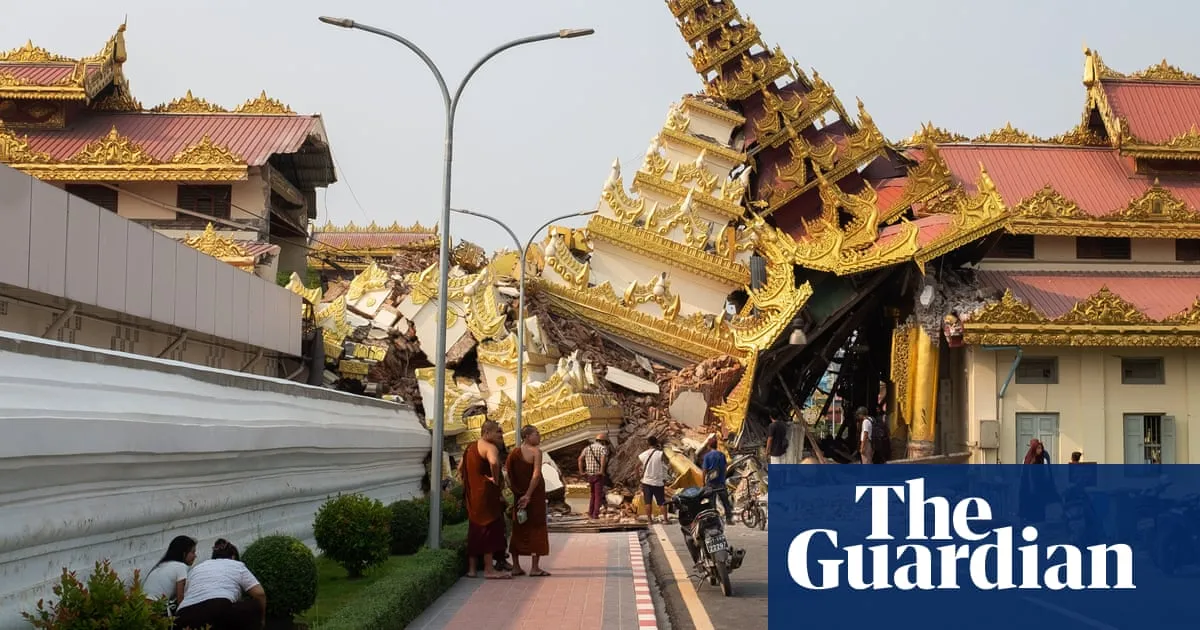
On Sunday, residents of Mandalay, Myanmar, were seen scrambling through collapsed buildings in a desperate search for survivors. This comes just two days after a catastrophic earthquake killed over 1,600 people in Myanmar and claimed at least 17 lives in neighboring Thailand. The initial quake, registering a powerful 7.7-magnitude, struck near the city of Mandalay on Friday afternoon, followed shortly by a 6.7-magnitude aftershock. The tremors led to widespread destruction, including fallen buildings, damaged bridges, and buckled roads, affecting the lives of the city’s 1.7 million residents.
As dawn broke on Sunday, local tea shop owner Win Lwin navigated through the debris of a collapsed restaurant on a main road in his neighborhood, painstakingly tossing aside bricks. “About seven people died here,” he recounted to AFP. “I’m looking for more bodies but I know there cannot be any survivors. We don’t know how many bodies there could be but we are looking.” Just an hour later, another small aftershock struck, causing panic as people rushed out of nearby hotels for safety.
Firefighters were mobilized from one of Mandalay's main fire stations to respond to the ongoing emergency. The previous night, a glimmer of hope emerged when rescuers successfully pulled a woman from the wreckage of a collapsed apartment building, prompting applause as she was transported to an ambulance.
Myanmar’s ruling junta reported on Saturday that at least 1,644 people were killed, with more than 3,400 injured and at least 139 still missing. However, due to unreliable communication channels, the full extent of the disaster remains uncertain in this isolated military-ruled nation, and the death toll is expected to rise significantly. In an unusual move, junta chief Min Aung Hlaing made a rare appeal for international aid on Friday, highlighting the severity of the calamity. Historically, previous military governments have rejected foreign assistance even in the wake of major disasters.
Myanmar has been grappling with four years of civil strife following a military coup in 2021. In a response to the earthquake, anti-junta fighters declared a two-week partial ceasefire in quake-affected regions, as stated by the shadow National Unity Government. Reports indicate that the military continued airstrikes in the aftermath, including just hours after the earthquake.
The government in exile announced plans to collaborate with the UN and NGOs to ensure security, transportation, and the establishment of temporary rescue and medical camps in areas under its control. This response underscores the critical need for coordinated efforts in the wake of such a devastating event.
Aid agencies have expressed concerns that Myanmar is ill-equipped to deal with a disaster of this magnitude. The UN’s humanitarian agency, OCHA, highlighted a severe lack of medical supplies and significant damage to infrastructure that is hampering rescue efforts. Hospitals and health facilities have either sustained extensive damage or have been completely destroyed, complicating the response further. “Telecommunications and internet disruptions continue to hinder humanitarian communications and operations,” OCHA said. “Damaged roads and debris are obstructing humanitarian access and complicating needs assessments.”
In a sign of hope, a convoy of 17 cargo trucks from neighboring China, carrying shelters and medical supplies, was expected to arrive on Sunday. Prior to the earthquake, approximately 3.5 million people in Myanmar were already displaced due to ongoing civil conflict, many facing food insecurity.
Across the border in Thailand, rescue operations were underway in Bangkok, where responders worked tirelessly to free individuals trapped under the ruins of a 30-storey skyscraper that collapsed during the earthquake. The Bangkok Metropolitan Authority reported 32 injuries and 83 individuals still unaccounted for, mostly from the construction site. Heavy machinery, sniffer dogs, and thermal imaging drones were deployed in an effort to locate any remaining survivors amidst the rubble.
Authorities have also announced plans to send engineers to assess and repair 165 buildings damaged in the city. The situation remains critical as the impact of the earthquake continues to unfold.
This tragic event underscores the urgent need for humanitarian assistance and the resilience of the communities affected by both natural disasters and ongoing conflicts.